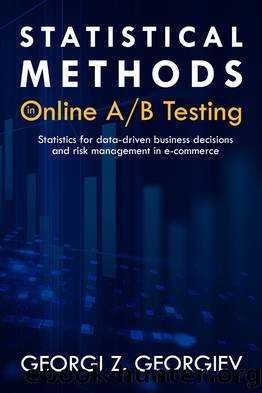Statistical Methods: in Online AB Testing by Georgi Z. Georgiev

Author:Georgi Z. Georgiev [Georgiev, Georgi Z.]
Language: eng
Format: epub
Publisher: Publisher
Published: 2019-11-15T00:00:00+00:00
6.6 Testing the perfect shade of blue
I would like to offer a humble reexamination of a famous test of this nature which was run by Google some time in 2008/2009. According to then Google executive Marissa Mayor, and a designer involved in the test (Holson 2009) (Hern 2014), two Google teams had to decide on the blue background of the toolbar across Google pages. A designer proposed one shade of blue which all designers liked. An engineer, however, tested another shade, and the data suggested that his blue worked better in driving clicks on the search results. The dispute was temporarily resolved by Mayor selecting a shade between the two shades.
However, afterwards a test was performed for each of the 41 shades of blue between the one proposed by the designer and the one proposed by the engineer. One shade was selected based on these experiments. There are conflicting accounts on what benefit this brought the company, since reports are mixing two different âshades of blueâ experiments, but the number $200 million is often cited.
While it is not entirely clear if Google ran 41 variants against a control in a single test, or whether they did 41 separate A/B tests, assume for argumentâs sake that they did run 41 variants against a control in a single test. Further assume that they applied correct adjustments for significance and sample size, and they were able to run the test in a timely manner. Even so, if you, dear reader, had to design the test, would you test 41 variants, knowing that this is increasing the time required to run the test by about 12 times compared to a simple A/B test between the two shades?
What if we are to consider the fact that blue is on a scale and whatever effect it has on users is likely âdose-dependentâ with a certain peak around the âbestâ shade of blue. With that in mind, it is more efficient to first run an A/B/n with just three variants against the control - two variants with each of the two shades proposed by the two camps, and then a shade exactly between them, versus a control with the current color, whatever it is.
This would have increased the sample size only by about 67% compared to a simple A/B test. Then another A/B/n test with several values around the winning shade could be run as well. This would have cut total execution time about four-fold, while having a high probability of homing in on the best shade of blue.
As an added benefit, during the duration of the second test the control and most variants would have an improved conversion rate relative to the baseline, meaning that we would be exposing significantly less users to suboptimal shades of blue. In other words, we would start gaining the benefits of the test much sooner than if weâd designed a large single test with 41 variants, only a handful of which would be close to optimal.
While most practitioners would either
Download
This site does not store any files on its server. We only index and link to content provided by other sites. Please contact the content providers to delete copyright contents if any and email us, we'll remove relevant links or contents immediately.
| CPA Test | GMAT Test |
| Statistics |
Cracking the GRE Premium Edition with 6 Practice Tests, 2015 (Graduate School Test Preparation) by Princeton Review(3625)
What It Really Takes to Get Into Ivy League and Other Highly Selective Colleges by Hughes Chuck(3242)
Fooled by Randomness: The Hidden Role of Chance in Life and in the Markets by Nassim Nicholas Taleb(2449)
The Marketing Plan Handbook: Develop Big-Picture Marketing Plans for Pennies on the Dollar by Robert W. Bly(2437)
The Tyranny of Metrics by Jerry Z. Muller(2435)
The Official Guide for GMAT Review 2015 with Online Question Bank and Exclusive Video by Graduate Management Admission Council (GMAC)(2354)
Ultralearning by Scott Young(2347)
50 Economics Classics by Tom Butler-Bowdon(2082)
The Visual MBA by Jason Barron(1649)
The Inevitable by Kevin Kelly(1571)
Data Science for Business by Foster Provost & Tom Fawcett(1529)
Out of the Crisis by Deming W. Edwards(1521)
GMAT Official Guide 2018 Verbal Review by GMAC (Graduate Management Admission Council)(1400)
Cracking the LSAT, 2012 Edition by Princeton Review(1365)
The Conflict Resolution Phrase Book by Barbara Mitchell & Cornelia Gamlem(1360)
Maths and Stats for Web Analytics and Conversion Optimization by Himanshu Sharma(1312)
The Personal MBA: Master the Art of Business by Josh Kaufman(1287)
College Essays that Made a Difference by Princeton Review(1279)
Cracking the SAT Premium Edition with 6 Practice Tests, 2017 by Princeton Review(1267)
